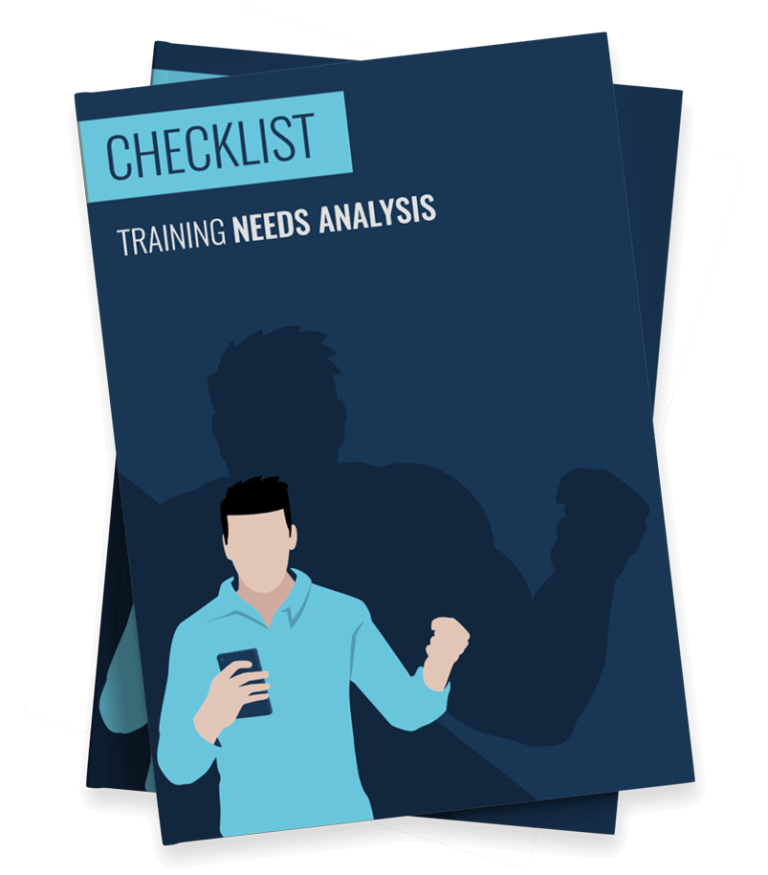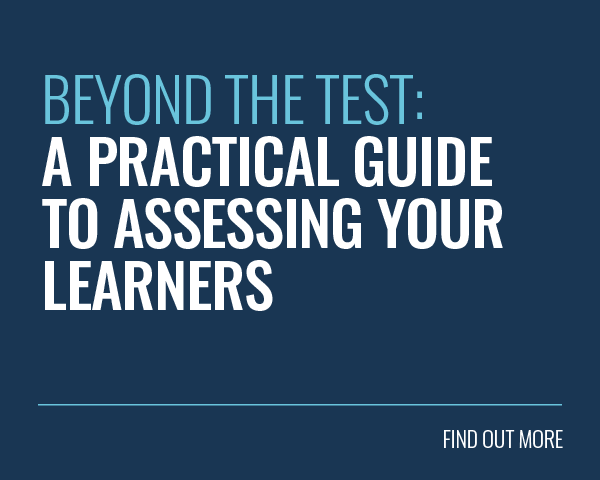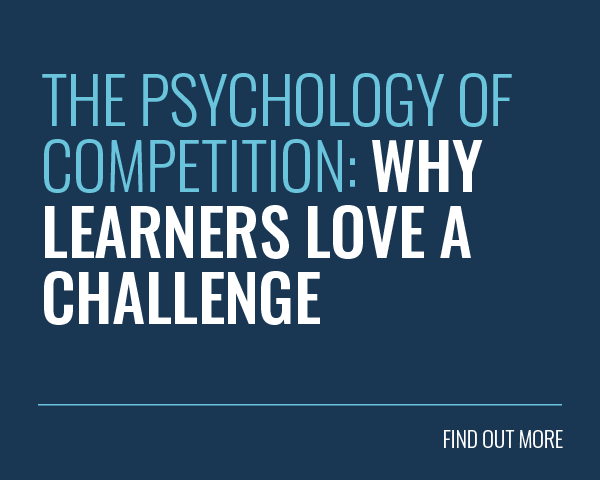
A training needs analysis is one of the most important things that you can do as a learning professional. But why is that?
Training can transform your business. It can give your people the skills and know-how they need to thrive. It can provide you with the edge your organisation needs to stay ahead of the competition. In fact, a great training programme will both entice top-talent to join your company and keep them there once they’ve joined.
It’s hard to overstate the importance of training in today’s workplace. It can:
- Identify skills gaps and help you plan training accordingly.
- Help you align training strategies with business objectives and values.
- Improve revenue by 24%.
As such, a training needs analysis (TNA) is supremely important. It’s your chance to plot the route to training success.
If you get it right, you’ll deliver the right training, in the right way, to the right people. As a result, you’ll start driving behaviour change, performance improvement and genuine business impact. On the other hand, skipping a training needs analysis altogether is the L&D equivalent of trying to pin the tail on the donkey whilst blindfolded.
In this article, we’ll teach you how to conduct an effective training needs analysis. But before that, let’s take a step back and dive into what a TNA actually is.
What is a Training Needs Analysis?
Put simply, a training needs analysis is: ‘the process of identifying training needs in an organization for the purpose of improving employee job performance.’
This process helps you review the state of your organisation’s training. It empowers you to identify the knowledge-gaps your organisation needs to fill. Once you know what’s missing, you can outline your priorities and shape your L&D strategy.
A training needs analysis gives you all the information you need to hone your L&D strategy into a well-oiled machine. There are three levels at which a training needs analysis operates:
- Organisational – This level is for the company as a whole. What is your organisation trying to accomplish? You’ll need to look at your current strategies, goals and future direction. This is vital, especially since companies that regularly set performance goals generate 31% more revenue than those that don’t.
- Team – This level dives a bit deeper and looks at individual teams within your company. It involves taking a look at the skill set of your team and objectives you have. Ask your team members how they can work better as a collective and what they’re currently missing to do so. Incorrect analysis is one of the top five reasons business teams fail.
- Individual – This level drills all the way down to individual employees. It’s important for employees to have goals for themselves that align with company objectives. A study of over 4,300 workers found that a staggering 74% felt they weren’t reaching their full potential. Performance reviews and one-to-one sessions are a great way to see where your employees are at. Then you can work out what they need to do to get them where they want to be.
The Benefits of a Training Needs Analysis
A training needs analysis is the most important stage in any training campaign. After all, it sets you up for future success. But how exactly do they help learning professionals?
1. Identifying Problem Areas & Setting Priorities

A proper training needs analysis establishes the gap between where you are and where you want to be. This will help you understand the skills and behaviours your organisation needs to advance. You can then identify which of these skills and behaviours are lacking.
For example, are there particular departments that are falling short? It could be down to rapid business changes or a lack of employee engagement.
Gallup found that a staggering 54% of employees are not attached to their work. Disengagement can start to affect the whole company, so it needs to be targeted first.
2. Fine-tuning Your Training Programmes

A training needs analysis gives you a clear understanding of the big picture. This enables you to make smarter decisions. With this understanding, you’ll be able to pinpoint training that’s needed and training that’s not needed, saving you time and money.
According to the 2020 Training Industry Report, company training costs $1,111 per employee. Multiply that by the amount of people in your company and that’s a figure you can’t afford to spend recklessly.
3. Increasing Your Training Programme’s ROI

Once you’ve identified the areas of greatest need and pinpointed surplus training, you can refine your L&D strategy. This helps ensure you’re funnelling investment into the areas that will deliver the best return.
It also means you will stop wasting your budget on ineffective training. A study by Accenture found that for each dollar spent on training, companies receive $4.43. That’s 343% ROI!
Of course, you can’t achieve this kind of return unless you’ve put in the work. You need to ensure you’re delivering the right training, to the right audience. A training needs analysis is the only way to make this happen. With this in mind, let’s explore the steps required to conduct a full analysis.
How to Conduct a Training Needs Analysis
Step One: Imagine
![]()
The best place to start with any training needs analysis is with your organisation’s mission and values. These will help you get to the core of why your organisation exists.
Once you understand the mission, take a deep breath and close your eyes. Imagine what your organisation would be like if it was fulfilling every aspect of this remit. Ask yourself:
- What would your company culture be like if your values were being lived all day, every day?
- Which groups of people are key to delivering your organisation’s mission?
- What behaviours do your people need to deliver this mission?
This organisation —the one you’re imagining — is the one you need to bring to life. Your training needs analysis is your strategy to do so.
Step Two: Assess

Step One will bring your ultimate goal into focus. With this clear vision, you now know what behaviours you need in your organisation. This means it’s time for you to work out how to get your people to adopt them.
BJ Fogg’s Behaviour Model outlines a path to behaviour change. His model explains that to affect behaviour change, you need three things: motivation, ability and a trigger. With these three elements in place, you can inspire learners to achieve anything!
Unfortunately, behaviour change doesn’t come easy. To achieve this goal, you need to understand what knowledge and support your learners require.
Research:
This calls for detailed research. L&D professionals use lots of different techniques to do this. This includes everything from focus groups to hiring consultants.
The most common technique would be the use of surveys, reviews and feedback. This requires a form with a long list of capabilities. Learners can then self-report on their competency level. This paints a rather limited picture of organisational capability. After all, it focuses on one (sometimes limited) perspective.
As such, in many cases, other individuals will also add their feedback. This could include the employee’s direct reports, manager, peers or even their customers. This helps to paint a 360 degree picture of employee performance and capability.
This process is often best handled through a learning management system, where it’s easier to track, maintain and analyse the data collected.
Analyse:
Now that you have a full survey of your organisation’s talents, you can plot them according to the departments they sit in.
With this information, you’ll be able to identify which skills you’re lacking and where they are needed the most. You can then sort through all the skills gaps you’ve identified and rank them according to importance.
This step is vital. 70% of employees believe that they don’t have the skills needed to do their jobs. Fortunately, 74% of them are willing to take the time to learn them!
Step Three: Plan

With all the detailed information you’ve gathered from your research, you now have the data you need to craft an effective training strategy.
This strategy should prioritise filling business critical skills gaps. Start by addressing skills gaps which are both important and urgent. After addressing these core skills gaps, you can work your way down the priority ladder until you’ve run out of budget, or run out of skills gaps.
You can then decide how you want to deliver your training and how you will reinforce it so that your training leads to long-lasting behaviour change.
You’ll now be in a strong position to start working out your expected ROI. You can begin by working out how much money you’ve saved by cutting unnecessary training. Then, you can set metrics to measure the success of future training.
Three Different Types of Training Needs Analysis
You now know what a training needs analysis is and how to do one. But one training needs analysis can be very different from another. In fact, you’ll never do a training needs analysis that’s exactly like another.
This is because the training needs of organisations change rapidly in response to changing workforces and a changing world. It’s estimated that 54% of all workers need to update or replace their skills due to the rapid technological developments. Just think about how quickly the COVID-19 pandemic changed training needs across the globe.
But, broadly speaking, a training needs analysis will fall into three categories:
Type One: Initial Training Needs Analysis
![]()
Before you even start designing your learning programme, you need to find out what you want your learners to take away from it.
A TNA flags up areas where skills and knowledge might be lacking. You can then focus your training programme on filling these skills gaps. This enables you to create focused content interventions, before moving onto topics which are already better understood.
Essentially, you’ll be crafting a training programme which has been personalised to suit your specific learners. It’s just like a jigsaw piece making a perfect fit!
Type Two: Training Needs Analysis for New Learners
![]()
As you flesh out your learning programme, you’ll end up building an impressive library of training content, covering absolutely anything your learners will ever need to know!
But with so much content to choose from, how can you make sure that your learners receive easy access to the things they need? After all, nothing turns off learners quicker than being forced to study something they already know inside out.
Once again, training needs analysis comes to the rescue! You can set up a simple questionnaire for new learners to take right at the start of their journey. The results reveal their individual needs and allow you to build a personalised learning pathway to suit them.
Creating suitable development plans and learning pathways is an essential part of any onboarding process. And effective onboarding makes employees 69% more likely to stay at a company for more than three years!
With an LMS, this process can even be automated. As learners answer questions, their skill gaps are revealed. The system then pushes relevant training content directly to the learner, giving them instant access to exactly what they need!
Type Three: Training Needs Analysis for Long-Term Learners
![]()
Holding regular training needs analyses can also be a brilliant way to help measure the effectiveness of your training programme. For example, you might repeat the process every six months to find out whether you’ve effectively plugged the skills gaps you were aiming for.
This way, you’re able to keep an eye on the skill set of your workforce and adapt your training programme if you spot new areas which need attention.
It also helps you to uncover the hidden champions amongst your learners. These are the individuals who have gained the most from your training.
These emerging experts can be assigned as subject matter experts (SMEs) throughout your training programme. They can help out other learners who might be struggling. This can improve workplace productivity by 50%.
Six Training Needs Analysis Top Tips!
Now you’re clear on what a TNA is. You also know why they are important and how to conduct one. So, let’s get into some top tips to make your analysis the best it can be!
Tip One: Use Your Analysis to Identify Subject Matter Experts

Where are you going to find the information that your learners need to succeed in their jobs? You could Google it. However, there’s a more efficient way to harvest knowledge and it’s right there on your doorstep.
You need to discover who the SMEs are within your organisation. They don’t just know their topic inside-out, but they know what it means within the context of your company.
Generally speaking, SMEs input into training will be an additional duty on top of their already-busy working day. They can be difficult to locate, but an effective training needs analysis can help. They will be highly-competent individuals who can help with skills gaps.
On Growth Engineering LMS, there’s a dedicated area for SMEs. This cuts down on time wasted trying to find the right person to ask and improves communication. This can improve productivity by 25%.
Tip Two: Review Roles and Competencies
Your business is a big machine with a lot of moving parts. Take some time to look at the various roles in your organisation and how these roles interact with one another.
Many of your day-to-day processes rely on a chain of different roles working towards the same goal. If one link in that chain is a little weaker, it has an effect on all of the others.
Perhaps your training needs analysis has illustrated a widespread lack of knowledge at an associate level. This may be the result of poor communication at a management level.
This essential competency must be addressed immediately since its impact is so large. 86% of employees and executives cite lack of collaboration or ineffective communication for workplace failures.
Tip Three: Pick the Perfect Delivery Tool for Your Organisation

What form is your training going to take? It could be face-to-face training or you could use online training solutions. What you choose will largely be dictated by budget and time constraints. But, the big question you need to ask yourself is which method will deliver the best return on your investment.
For example, classroom training may be easy to arrange and relatively uncomplicated. But with the additional costs it entails, such as travel and venue expenses, the total investment can become substantial.
The effectiveness of this type of training can also be difficult to measure, which can make calculating the return on investment tricky.
An online training solution is more direct. You can gain a clear picture of how effective each piece of learning content is by looking at reporting. It’s also generally cheaper. For example, Microsoft used video to cut classroom training costs from $320 per person to $17.
To make an effective decision, you first need to understand what the objectives of your learning intervention are. A training needs analysis lets you know where the goal posts are, so you can make sure you’re playing on the best possible pitch.
Some objectives are better served by face-to-face training, others by a digital approach and others still by blended learning.
As an online training company, our opinion might be a little biased! However, we’ve seen first-hand the effect online learning can have on your ROI. For example, Growth Engineering Learning App caused a 20% increase in sales revenue for territories using it. That’s some serious ROI!
Tip Four: Using Analysis to Make Smarter Content Decisions
At some stage, you’ll need to start creating training content. This is the meat and bones of your training programme. It could be face-to-face classroom sessions, eLearning units, videos, documents and so on.
If you’ve completed a training needs analysis, you’ll know where the gaps are and where your efforts should be focused. If your learners are lacking in product knowledge, for example, you need to find the most effective way of giving them that knowledge so that it is absorbed and retained.
Here, we’re hitting on the biggest challenge that training professionals face today — engaging their learners. It’s easy to put a slideshow together, but learners today demand something more interactive. As content moves more onto physical devices, interactivity and richness in learning becomes expected
Something that we know works extremely well is gamified content. This is where you add game mechanics to a non-gaming environment — such as your training content. Rewarding learners for actions like completing content can boost engagement by up to 60%!
Tip Five: Use Feedback to Shape Success
Collecting learner and stakeholder feedback should play a key role in your analysis process.
Before you go off making a bunch of mistakes, you should review your company’s previous approach to training. That will provide you with a whole repository of lessons that can shape your new training programme.
- What did learners say could be improved?
- What content did learners engage with the most?
- Where were the stumbling blocks in your previous programme?
Companies that implement feedback have a 14.9% lower turnover rate than those that don’t. You can also discover what has produced great results in the past and replicate them!
Tip Six: Personalise Every Step of The Journey

The very best thing about a training needs analysis is that it helps you to deliver relevant content to your learners. Nobody wants to complete content that’s out of date or not helpful for their role. This can be disengaging for your learners. It may seem like you don’t care about them!
If you deliver content that’s useful to them, it shows that you care about their personal development. Because of this, 77% of L&D professionals say that personalised learning is essential for employee engagement.
It’s also a powerful way to increase memory retention. Neurologist Dr. Judy Willis states that “memories with personal meaning are most likely to become relational and long-term memories available for later retrieval”.
Final Words
Once you’ve been through and completed a full training needs analysis, what’s left? Well, it’s time to put your plan into action. Every journey starts with a single step. When it comes to L&D, the first step is a training needs analysis.
As you’ve seen, when you undertake a thorough training needs analysis, it gives you all the data you could need. If you use this data to its full potential, your chances of an interstellar training ROI will shoot up!
Ready to start the process? Download your interactive checklist by clicking the link below!






